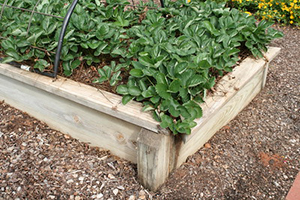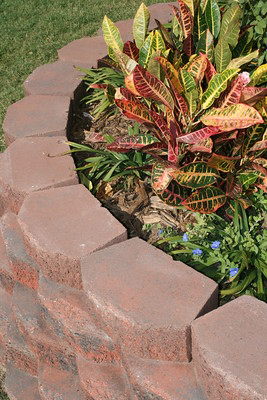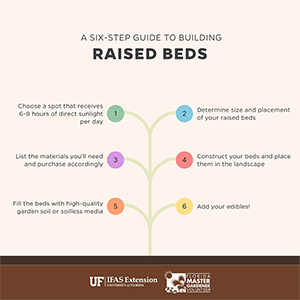Building Raised Beds

Home food production is a growing trend in Florida gardening once again. There's a new wave of gardeners who are hoping to grow their own food and live a more sustainable lifestyle.
Gardening in raised beds can help improve yields and reduce maintenance in your home vegetable garden. Here we will walk you through the steps to build raised beds. For more on caring for your beds and plants, see our article Raised Beds: Benefits and Maintenance.
Materials and Construction
While raised beds do not technically need a framework, we do recommend one for long-term gardening. Frames can be constructed using a variety of materials, including brick, rot-resistant lumber, landscape timbers, and concrete blocks. Beds can also be elevated for gardeners who want to avoid working at ground level.
Generally, wood-based products are less expensive than stone or masonry materials. Sometimes it is possible to get building materials secondhand at little or no cost. While recycled lumber is not a good choice for edible gardening, used bricks, concrete blocks, and other recycled materials are an option. To tie your landscape elements together, match your raised-bed materials to other materials used in your landscape.
Here are some popular materials used to construct raised beds:
Wood / Lumber
- Untreated lumber – begins rotting within a year, but it is safe for edibles
- Naturally rot-resistant lumber – examples include redwood or cedar
- "ACQ Ground Contact" treated lumber – approved by the Food and Drug Administration for food production
- Synthetic lumber – made of recycled plastic
Other Materials
- Brick or stone – long-lasting but often expensive
- Large, grouped containers – examples include half-barrels and large terracotta pots
- Concrete blocks – may result in an alkaline soil pH but the effect will decline over time
- Poured concrete – check that curing compounds, stains, sealers, and release agents are safe for use in edible gardening; as with concrete block, an alkaline soil pH may result
Cautions for Vegetable Gardeners

Whether you are a new or an experienced vegetable gardener, a cautious approach to edibles is wise. Products and building materials you might use for ornamental plants are not always suitable for edibles.
Many of the pesticides you would normally use in your ornamental beds are not safe for edible crops. Always read the label; it's the law. When in doubt, contact your county Extension office for assistance.
Avoid the use of secondhand lumber, such as that from pallets. Some lumber is treated with creosote or pentachlorophenol. These chemicals can leach out and injure plants.
Avoid recycled landscape timbers and railroad ties. Prior to 2004, these may have been treated with compounds that contain arsenic. New lumber is no longer treated with those compounds.
If you're uncertain about the safety of treated lumber, place a heavy plastic liner between it and the soil used for growing plants. This will prevent direct contact of plant roots with the treated lumber. Be careful not to tear the plastic when tilling.
Construction Tips for Raised Beds
Raised beds can be as simple or as elaborate as you'd like them to be. Here are some general steps for constructing the frameworks.
Step 1: Choose a spot in your landscape that receives 6-8 hours of direct sunlight a day. The most convenient sites are flat and located near a source of water. If the area is part of an existing lawn, remove the top layer of grass or cover the turf with recycled cardboard, or black and white newspaper.
Step 2: Measure your site and determine the size and placement of your raised beds. Here are some guidelines:
- Width – Beds should be no wider than 4 feet. In larger beds the center can be difficult to reach.
- Length – Eight feet is a common length, but there is no one-size-fits-all for raised beds. The length should match your site and budget.
- Depth – The depth of the bed should be between 6 and 24 inches deep. Deeper beds are more expensive because they require more materials. Shallower beds cost less, but may be more difficult to access. If you want the surface of the bed to be higher than 24 inches, consider elevating the entire bed above ground level. Add a sturdy bottom, with drainage holes.
- Spacing – Leave a walkway of 18 inches or more between the beds for weeding and harvesting. Wider walkways will make the beds more accessible. For wheelbarrow access, we recommend leaving 3 feet between beds.
- Orientation – A north-south orientation is best for low-growing crops. This allows direct sunlight to reach both sides of the bed. Beds that will contain taller crops do best with an east-west orientation. This is appropriate for plants such as pole beans and caged tomatoes.
Step 3: Once you know how big the beds will be, list the materials you'll need and purchase accordingly. A materials list and detailed instructions for building a 4' x 8' x 21¾" wooden framework can be found in the publication Gardening in Raised Beds.
Step 4: Construct your beds and place them in the landscape. Measure the space between them and check that they are accessible before you continue. If weeds have been a problem on the site, line the bottom of the beds with 4-5 layers of newspaper or cardboard to create a weed barrier.
Step 5: Fill the beds with high-quality garden soil or with soilless media. Using new media rather than soil from your landscape will help the plants thrive. You'll also get a fresh start in the battle against weeds. This is also a good time to till in organic soil amendments, such as compost or manure.
Step 6: Add your edibles! Most garden vegetables will grow well in raised beds. Still, seasons matter. Cool-season crops require cool weather, even in raised beds. Plant the vegetables appropriate for the current growing season. You will find the Florida Vegetable Gardening Guide helpful in choosing vegetable varieties for our state. This guide also includes planting dates for your region and other valuable information on vegetable gardening. For more on caring for your beds and plants, read Raised Beds: Benefits and Maintenance.
Also on Gardening Solutions
- Applying Fertilizer to Vegetables
- Organic Matter
- Raised Beds: Benefits and Maintenance
- Square Foot Gardening
- Vegetable Gardening in Florida


